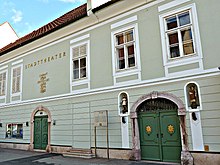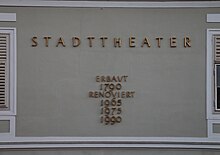City Theater Leoben
The Stadttheater Leoben is the oldest continuously operated theater in Austria and celebrated its 225th anniversary in 2015.
history
Beginnings and 19th century
As early as the 18th century, there were plans in Leoben to build its own bourgeois theater. In 1790, the premises at Homanngasse 5, called “Hofstätterisches Haus”, were adapted as a theater. Most of the funding for the renovation was taken over by the population, although the venue was also viewed as a theater by and for the people. The theater was subsequently run by an association which donated the profits to charitable purposes. By 1830 the theater already had an 18-person play troupe. The most popular guests at this time included Charles X , " King of France and Navarre ", Maria Christina of Naples-Sicily and Anton , King of Saxony .
The current building was built around 1850 as a classical , two-story building. While initially only lay people appeared, a separate ensemble gradually formed. In 1861 the theater was taken over and subsidized by the municipality, whereupon a new era dawned. Under professional guidance, the well-known playwright Ludwig Anzengruber appeared in a performance of Schiller's Kabale und Liebe in 1864 . One year late, the 100th anniversary of the city theater was celebrated in 1891. Various premieres followed on this occasion, including Johann Nestroy's Der böse Geist Lumpacivagabundus , Henrik Ibsen's Ghosts and Carl Maria von Weber's Der Freischütz .
In the season 1898/99 there were operettas for the first time in Leoben, after they had already celebrated great success in Graz . At the time, the program featured Die Fledermaus or The Gypsy Baron by Johann Strauss Sohn or Orpheus in the Underworld by Jacques Offenbach .
20th century
From 1900 a noticeable upswing followed and the up-and-coming Leoben theater enjoyed great fame, with court actors often applying for guest performances. After Goethe's Faust was performed for the first time in Leoben in 1900/01 , other important pieces such as Don Carlos , Die Räuber , Maria Stuart , Emilia Galotti , Othello and Hamlet followed in the following years . The theater's success was only interrupted by the First World War, when there was a sudden lack of audience and staff, whereupon the city subsidies were also discontinued.
During the First World War, the long-time director Robert Roberti took over the theater in 1915. Through him, the house was put back into the service of charity and widows, orphans and war hospitals were supported. In order to distract the population from war events and acts of war, more entertaining plays were performed. After the end of the war, the theater was temporarily converted into a cinema due to an economic emergency. In 1921 it was rebuilt into the actual city theater with a permanent ensemble. One of the highlights in the 1920s was a guest performance by Paula Wessely , who was still largely unknown at the time , later wife of Attila Hörbiger and mother of Christiane Hörbiger , Elisabeth Orth and Maresa Hörbiger , in 1928.
In the following 1930s, the theater was also marked by the global economic crisis , as the economic situation in Austria had also deteriorated and for this reason the tiers were mostly empty during this time. In addition, the ensemble noticed the crisis and only received its fee in installments. There was also a lack of money to celebrate the 140th anniversary. Instead, there was an anniversary week in which pieces such as Faust or Grillparzer's Weh dem die der Lies! were listed. But even the increasingly tense political situation did not invite visitors to the theater; the outbreak of the Second World War then made its mark.
With the annexation of Austria to the National Socialist ruled German Reich , the Leoben City Theater was renamed the Alpengaubühne . This name did not last long, however, and it was renamed the Styrian State Theater again . However, this was no longer run in Leoben, but settled in the provincial capital Graz. To mark the 150th anniversary in 1941, the ensemble of the Baden City Theater performed the tragedy The Nibelungs in the mining town. Following the Second World War, attempts were made to establish the theater as a three-city theater for Leoben, Bruck an der Mur and Kapfenberg and to build up a new, independent ensemble.
A high point in the 1940s was an open-air performance of Jedermann by Hugo von Hofmannsthal in 1949. Attila Hörbiger took on the title role against the backdrop of the parish church of Leoben . At the same time, however, this performance was the last collaboration of the urban ensemble, which for economic reasons could no longer be held. In 1962, long-time director Robert Roberti, who took over the theater at the age of 33, retired at the age of 80. Three years later, the entire interior of the theater was completely renovated, with only the stucco ceiling from the historicism period remaining. One year later, the theater celebrated its 175th anniversary with the Austria-wide premiere of Haydn's opera Untreu is not worth it ( l'infedeltà delusa or Die gefitelte Infreue ).
In the following two decades, the Stadttheater Leoben was mainly performed by the Vereinigte Bühnen Graz and various touring stages.
1990s to the present
From the 1990s onwards, the plays were slightly reduced and renowned actors, entertainers and cabaret artists were invited to Leoben again and again. From Götz George to OW Fischer , Senta Berger , Otto Schenk , Alfons Haider and Elfriede Ott , a great many, above all Austrian artists, have been guests in the Stadttheater. Frequently booked regular guests include the duo Dorothee Steinbauer / Wolfgang Dobrowsky as well as cabaret artists such as Thomas Stipsits from Leoben or his long-time friend and colleague Manuel Rubey .
In 1995, with the operetta Die Fledermaus , musical and operetta in-house productions were performed for the first time in a joint project by the city theater, the Leoben Music and Art School and the Graz University of Art . Up to 2009 there were performances of 15 different pieces. The leading group of people around Horst Zander , Hannes Moscher and Karl-Heinz Tint were awarded the culture prize of the city of Leoben for their artistic work. Renowned Austrian operetta ensembles have made guest appearances in Leoben every year since 2010. Furthermore, with the Verein Junge Bühne Leoben, an association was founded that continues the tradition of Leoben children's fairy tales and performs various fairy tale productions. In a Leoben municipal council meeting in May 2019, over 300,000 euros were approved for the cultural sector; 37,000 euros of this will be used to refurbish the seating and replace the curtains in the city theater. A large part of the money is earmarked for the theater schedule and the 2019/20 concerts. Also in 2019/20 the city theater was expanded to include the premises of the jeweler located on the corner of Homanngasse and Straussgasse, whose branch there had been closed.
The Leoben city theater today has 283 seats and 105 standing places and has been under the direction of the cultural manager and head of the presidential department of the city of Leoben, Gerhard Samberger, since January 1st, 2003. The building at Homanngasse 5 is a listed building.
Web links
Individual evidence
- ↑ a b Obersteirische Rundschau , 29./31. May 2019, vol. 8, No. 11, p. 10
Coordinates: 47 ° 22 ′ 48.6 ″ N , 15 ° 5 ′ 37 ″ E


